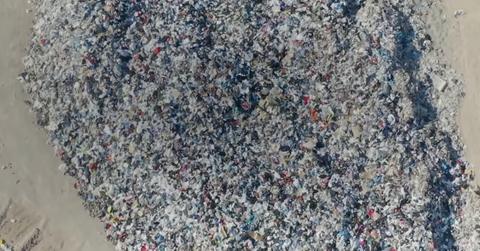Piles of Discarded Fast Fashion Items in the Atacama Desert Are Visible From Space
Updated June 1 2023, 4:04 p.m. ET
The building evidence of how fast fashion destroys the environment is especially relevant in the Atacama Desert in Chile, where a pile of discarded clothes is now visible from space via satellite. The fast fashion industry causes between 2 to 8 percent of the world's carbon emissions, according to a 2018 study by the United Nations.
While some have argued that fast fashion allows consumers to purchase trendy clothes at affordable prices, in truth, garment workers and the environment pay the price. Keep reading for what you need to know about the situation in the Atacama Desert and why the new satellite images should be a wake-up call for consumers.
A pile of fast fashion clothing items left in the Atacama Desert is visible from space.
On May 10, 2023, a satellite photo of the discarded clothing in the Atacama Desert was posted by SkyFi, developers of a satellite photo and video app. "The 50-centimeter resolution image, which is classified as Very High Resolution, was taken using satellite imagery, and it shows how big the pile is compared to the city in the bottom of the picture," they wrote in a blog post.
The blog post also acted as a call to action, saying, "The size of the pile and the pollution it's causing are visible from space, making it clear that there is a need for change in the fashion industry."
According to a study from Agence France-Presse (AFP), Chile has been a "dumping ground" for fast fashion items since at least 2021. The article reports that garments are made in China or Bangladesh before eventually arriving in Chile and occasionally resold in Latin America. The study also found that "59,000 tons of clothing" arrive in Chile yearly.
Some items are smuggled out to other countries, but the remaining 39,000 items are left in dumps to sit and pollute the area.
Franklin Zepeda, the founder of EcoFibra, a sustainable company that aims to reuse textiles for insulation, told AFP that many of the garments can't be sent to landfills. "The problem is that the clothing is not biodegradable and has chemical products, so it is not accepted in the municipal landfills," he said.
Environmentalists are hoping that the shock of a photograph will help emphasize the dangers fast fashion presents to society.
In 2022, international media project Peoples Dispatch reporter Jason Mayne also posted photos and took video footage of what the garment dump in the Atacama Desert looks like, with several images clearly showing items bearing tags from companies such as T.J. Maxx and Shein.
Thankfully, there are solutions for those who want to stop participating in fast fashion, including seeking out sustainable clothing brands or thrifting. It's important that consumers continue to recognize the enormous impact fast fashion has not only on those creating the clothing, but on the environment.


